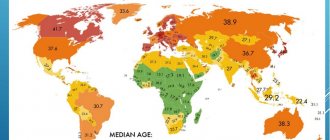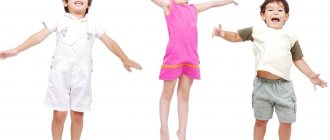Raising a child is a responsible process, so parents should turn to the experience of domestic and foreign psychologists who have examined various processes of personal development. The most interesting and practically applicable is the theory of sensitive periods, which was introduced by Maria Monessori. According to this concept, each specific age, starting from early childhood, is optimal for engaging in a certain type of activity.
Definition
Let's consider what this concept means. The sensitive period is the period of children’s receptivity to certain activities, the time when they are most ready to learn something specific, to learn any type of activity. The word has Latin roots and means "sensitive".
Knowing the features of these periods of development is especially important for responsible parents, since psychologists note that premature or late training in one or another type of activity will ultimately not be entirely effective and may even have an adverse effect on the development of the psyche. Moreover, such periods have a certain duration, but go away irrevocably, so if the moment is missed, then nothing can be corrected.
On the contrary, understanding sensitivity will help parents structure the learning process in such a way that children will comprehend the material with pleasure and ease.
Despite the fact that there are clearly defined universal periods, the development of each baby is individual, so parents should focus primarily on their own child, and not on general recommendations.
In psychology, the definition of the sensitive period is given in sufficient detail, but it should be noted that it cannot be equated with the specific age of the child. The highest intensity, that is, the child’s maximum readiness to comprehend this or that activity, can be found in different children at different ages.
Recommendations
Today, many parents are aware of the importance of early development of children. What we have learned about sensitive periods, on the one hand, confirms this idea. On the other hand, the desire of parents almost from the cradle to load their baby with serious classes in a foreign language, sports, dancing, reading and other subjects useful for his future seems controversial.
It is more correct to listen to nature in order to give the child the maximum number of opportunities for development in a favorable period, to create conditions in which the formation of different aspects of the child’s psyche will be optimal. For this:
- Watch your child. Remember that a child’s commitment to any activity or object is a sure sign that he is at the peak of the corresponding sensitive period.
- Try not to miss time, because favorable periods pass irrevocably. Prepare in advance for the onset of the next period: prepare the environment, select didactic material, think over ways of studying.
- Remember that sensitive periods vary from person to person. For different children, their timing may be different, and the severity of the peak period may also be different. Assuming the onset of a period, work with your child in his zone of proximal development. Then it will be easy to notice the beginning of the period.
- During the onset and peak period, try to give your child as much material to study as possible. At this moment, do not be afraid to overload it - the speed of perception and processing of material corresponding to the period increases by 10-15 times (compared to normal time).
- There is no need to fight nature; do not force your child to do something under duress. The result will most likely be mediocre. On the contrary, activities within the framework of a favorable period will not only bring great results, but will bring joy to both the baby and his parents.
About the role and significance for parents
Each such period is characterized by certain specific development:
- the onset is slow and difficult to detect, so specific age intervals must be precisely known;
- the maximum point is the greatest degree of manifestation of the sign, maximum intensity, it can be identified without problems;
- decline, gradual decrease in intensity.
To understand the essence of the term, we can give a simple example characterizing a complex psychological phenomenon - such periods are compared to windows. First, the window gradually opens, then it turns out to be completely open (this is the maximum intensity), then it closes.
Many sensitive periods in children pass at the same age, but different children reach their highest intensity at different moments.
Moms and dads can use their knowledge of sensitivity in different ways:
- understand what exactly happens to the baby at one time or another;
- figure out when the next stage will approximately arrive and have time to prepare for it.
By focusing on sensitive periods, parents can organize the learning process in such a way that the child will demonstrate excellent results, without getting tired or capricious, performing those actions that suit him best.
If you force a child to do something without taking into account the presence or absence of a sensitive period, he will not show good results, but when the period comes, he will reach the necessary knowledge on his own.
How scientists learned about sensitive periods
At the beginning of the 20th century, Dutch biologist Hugo De Vries studied the process of transformation of a caterpillar into a butterfly. He discovered that a caterpillar, born at the roots of tree branches, strives for light - at the ends of the branches it finds the thinnest and youngest leaves for food. When this need is satisfied in the caterpillar, sensitivity to light decreases and then gradually disappears. And the caterpillar turns into a butterfly.
This theory became popular in the scientific community and manifested itself in the concepts of various scientists. Among other things, she influenced the work of Maria Montessori in Europe and Lev Semyonovich Vygotsky in Russia. They believed that the same thing happens with children - they experience similar transformations during their development.
The idea of the existence of periods favorable for certain transformations and development was strengthened by Maria Montessori when she began to study the works of the French physician Jean Paul Gaspard Itard. He is known as the educator of the so-called Aveyron savage - a boy of 12 years old, who until that time was completely isolated from people. The boy lived and was raised among animals, so he moved and communicated in unusual ways.
Gaspard Itard was sure that if conditions were created and practice was given, the child would learn to speak. The boy did acquire some skills, but he never reached a normal level of development for his age and was unable to learn to speak.
Montessori suggested that there is an optimal age for speech development, and if this age is missed, then speech does not develop. This is what happened to the boy Gaspar Itara.
In the times of Maria Montessori and L. S. Vygotsky, there was no evidence of the existence of sensitive periods. Scientists made their conclusions based on observations of children and they were right. It is not for nothing that they are considered geniuses of pedagogical and psychological thought.
In 1996, the first scientific evidence of the existence of sensitive periods of development was obtained . Neuroscientists have discovered that at certain times in children, some neurons become more active than others. At moments of activity, these neurons are combined into neural ensembles, which are responsible for the child’s interest and desire for certain types of activities.
After some time, the ensembles regroup: some neurons turn off, other neural connections begin to form, and new ones are created. The brain chooses: I will support these connections now, but not these. During the regrouping of neural ensembles, the baby suddenly ceases to be interested in what he was very passionate about just yesterday. But interest arises in other things.
Scientists call such periods of time “windows of opportunity,” or sensitive periods of development.
Here are the characteristic features of sensitive periods of development:
- Universal . They appear in all children, regardless of the culture, era and family in which the child is raised. At about the same time, children begin to talk and crawl, become indignant at the disruption of their usual way of life and pick up specks from the floor. But the exact start, peak and end times vary from person to person. At the same age, some children are more focused on communication, while others are more focused on movement.
- Temporary . Sensitive periods begin and end within a certain time and do not last a lifetime. As soon as the window of opportunity closes, children begin to show complete indifference to what just recently attracted and interested them. Subsequent mastery of skills and abilities will no longer be so effective, easy and joyful. Often these skills are mastered outside the sensitive period with some impairments. For example, learning a new language at an older age requires more effort than during the sensitive period of language development.
- Unconscious . Children are absolutely unaware of what is happening to them. It’s as if they have some kind of engine inside them that drives them towards certain objects or phenomena in the environment. Kids cannot say: “Mom, I have entered a sensitive period of speech development, so I need close communication and books.” So we need to observe and identify the peaks ourselves.
150 toys and activities for home
Free selection for children from 0 to 5 years old
To learn more
Periodization
Montessori identified a number of periods, information about which is presented in table form.
| Age | Characteristic | How to use |
| 0-3 years, “spiritual embryo” | The child is completely dependent on the mother and her emotional state, and strives to communicate with adults. Most often not ready for kindergarten. | It is advisable for parents to communicate with the baby as often as possible at this time and surround him with love and care. |
| 3-6 years | The baby begins to become aware of himself, and a favorable time comes for the development of sensory organs, speech, and understanding of social roles. | The child should be given the opportunity to comprehend the world around him, actively engage with it, and not let the process take its course. |
This is the most general periodization proposed by Montessori. Next, the main sensitive periods of preschool age will be considered.
Soviet psychologist Lev Vygotsky, who proposed the term itself, took a slightly different approach to identifying sensitive periods. For example, in the development of a baby’s speech there were 5 of them:
- from 1.5 to 3 years – development of motor skills and recognition of new words;
- 3-4 years – speech awareness;
- 4-5 years – perception of writing, understanding of size, color, shape;
- 5-6 years – ability to learn reading and writing, emergence of interest in communication;
- 8-9 years – renewed interest in the native language.
According to Vygotsky, the sensitive period for the development of reading and writing is preschool age - 5-6 years. The psychologist considered the periods themselves to be the result of mental functions of processes.
What to do if windows of opportunity have already closed
If sensitive periods have already been missed, we will not be able to return them. Therefore, we can only come to terms with the fact that there was no knowledge and we could not pay attention to what was important in the development of our baby.
But don’t despair or blame yourself, children are not so fragile - they are flexible, strong and resilient. Take a closer look, because right now the child is demonstrating his new interest. Therefore, you can focus on providing as many opportunities as possible to meet current needs.
Missed skills can be taught gradually. Conflicts have begun with your preschooler regarding order - you will have to be patient and constantly remind the child of the need to clean up after himself. If you missed the crawling stage, you can make up for it by playing in mazes or rock climbing. This will not cause much joy or interest for the child; he will need to make more efforts, but he will learn the skills. Although not as ideal as in the sensitive period.
In the article, we examined in detail what sensitive periods are and how knowledge about them helps create better conditions for the development of children. A child will never have such favorable opportunities for mastering new skills as during these periods - after all, all the needs of physical and mental development are concentrated in them. If we miss them, they are gone forever.
When we see the needs of our baby, respond to them and improve the environment, then whims, hysterics and whining go away. The time has come for positive emotions: joy, pride from success, passion. We do not encounter problems or difficulties. After all, now our child is busy with really important activities, which he is interested in at the peak of his receptivity.
Speech development period
For the development of a child’s speech, the period from birth to 6 years is sensitive, but several stages are distinguished.
- In infancy (up to 4.5 months), babies already perceive speech and often try to turn towards its source. If parents do not observe this, there is a high risk that the baby has hearing problems - they should be shown to a specialist.
- Up to one year old, babies strive to reproduce previously heard sounds, that is, to imitate. At this time, emotional communication with the mother is of great importance for the baby. Often children build their own sound series, pronouncing one imitation sound after another.
- At about a year old, the child utters his first word, verbally expressing his thoughts.
- At 1.5 years old, the baby begins to express feelings and desires in speech, so parents are required not to “little” the baby, but to speak to him in the correct language and set an example.
- At 2-3 years old, children often have conversations with themselves, uttering their own thoughts. Knowing this, parents have an excellent opportunity to look into the child’s inner world and understand what he is thinking about. If a child has not received the first ideas about human speech before the age of three, then he will not learn to speak in the future. Let us recall the examples of children raised in the wild jungle by a pack of monkeys - when they returned to civilization, they were unable to adapt and did not even master the gift of speech.
- 3-4 years is a period of active replenishment of the vocabulary, so the mother should work with the child, talk about natural phenomena, seasons, animals and birds, and household items. This will help your baby learn and remember new words. After three years of age, you can begin to carefully teach your child letters; he will enthusiastically engage in writing. Parents can show creativity by asking the little one to sculpt letters out of plasticine, fold them out of wire, and write them on semolina scattered on a plate.
- At 4.5–5 years old, a child is already able to begin learning to write. He will have no problem writing his own name in block letters and will be happy to count, so parents can begin the appropriate lessons that will help prepare for primary school.
- 5 years is the optimal age to start learning to read. Sometimes children who have been taught to write, intuitively, begin to read on their own, although no one taught them this - this is a feature of the period.
Of course, age limits are largely individual, but the sequence of developmental stages is the same for every child, regardless of gender or family status. Obtaining skills should be carried out in accordance with the psychological characteristics of the baby.
Main sensitive periods
Scientists still do not have a consensus on how many windows of opportunity open to a child. Maria Montessori did not identify a clear list, so the works of followers indicate four, five, six and even twelve.
We will look at six sensitive periods:
- Speech development: from 7 months of the intrauterine period to 9 years, peak 1–2.5
- Movement development: from birth to 4.5 years, peak 2–2.5
- Perception of order: birth to 4 years, peak 2–2.5
- Development and refinement of sense organs: from birth to 4 years, peak 3–3.5
- Perception of small details: from 1.5 to 2.5 years
- The period of development of social skills and norms is from 2.5 to 5.5 years, peak at 4.5
Table of sensitive periods. Shaded areas show approximate development peaks
Perception of order
Lasts from birth to 4 years, the highest intensity occurs at 2–2.5 years.
Clutter disorganizes kids and leads to stress. Moreover, in a disordered environment, they do not form a stable idea of the world as something basic and safe. Order serves as a support, and chaos leads to increased anxiety, uncertainty, whims and hysterics.
Order is stability and security.
The baby needs order in three areas:
- in the environment;
- in time;
- in the behavior of adults towards the child.
Order in the environment. It is important that the child can find the same thing in the same place; this helps him understand the purpose of objects. He begins to understand that dishes are used for eating, and toys are for playing. That after a walk we take off our shoes in the hallway and eat at the table. There should be a corner for educational activities and a place to sleep.
In my practice, there was a critical case when a grandfather came to visit a family with a two-year-old girl. The grandfather was placed in his granddaughter’s room, and the granddaughter was placed with her parents. Suddenly, the baby began to show outbursts of aggression - she threw objects, tried to bite other children in the garden, showed auto-aggression: she fell, hit the corners of furniture.
There was a time when she broke her forehead at home and had to stitch it up. This behavior was explained by the fact that the girl was in a sensitive period of perception of order. I advised the parents to move the grandfather into their room and return the baby to hers. After returning to her usual routine, the girl’s outbursts of aggression and injuries stopped. Gradually she returned to her usual state.
Closer to two years, at the “height” of the sensitive period of order, the baby shows especially strong persistence in maintaining the order that is familiar to him. He himself tries to return objects to their place and is indignant if you decide to shorten a familiar story while reading: “No! First the boy called the cat!”
Order in time. For a child, consistency in events is very important - so that everything happens the same way every day. For example, so that he goes to bed at the same time, after the same rituals. Therefore, adults need to monitor the child’s daily routine.
In addition to a sense of security, order in time will help the baby understand his rhythm of the day - it will start the course of the internal biological clock, which is easiest to rely on in early childhood.
Order in the behavior of adults towards a child. This means that all family members react equally to the same actions of children. If mom forbids eating in front of the TV, then both dad and grandparents follow this strategy.
When adults demand different things, it is very difficult for a child to adapt. With age, he will begin to use this, maneuvering between his parents, but this will not give him a sense of safety and security. Rather, it will teach him to lie and he will be very easy to manipulate mom or dad.
One of the most interesting manifestations of the sensitive period of order is that children are constantly testing boundaries. They often break some rule and see how family members react to it. Parents may interpret this as a sign of mischief or bad character. Actually this is not true. He does this not out of spite, but to make sure that the rule remains unchanged. He seems to confirm to himself that yes, the rule exists, it is constant, the environment is safe.
If the parent begins to change the rules and back down, this causes even more anxiety for the baby. He begins to test the boundaries further and further, breaking one rule after another. And as a result, his behavior becomes uncontrollable.
Let's consider an example when a baby always washed his hands before eating, but one day he refused to do so. In this situation, the mother should calmly remind her of the rule and insist on her own. An important key is to keep the tone calm. But the baby is deprived of the opportunity to sit at the table with dirty hands. He may throw a tantrum and try to take food with dirty hands, but it is important for parents to calmly repeat the rule and calm the baby down.
The rule should not change because of hysteria. If a momentary desire is satisfied due to hysteria, then hysteria is a way to get what you want. A method that exhausts not only you, but also the baby. Although he seems to be achieving his goal, he does not feel calm, since the inconstancy of the rules unnerves him. In this case, the hysterics will only intensify. And if you are firm in following the rule, then the very next day the baby will go and calmly wash his hands before eating - he realized that this rule is inviolable and order has been restored in his life. This behavior from the mother will show that the needs are taken into account.
Development of movements
This sensitive period of child development lasts from birth to 4.5 years, with a peak at 2–2.5 years.
The child goes through a colossal path in the development of movements: in the first month of life he can hardly raise his head, and after a year he tries to take the first step and throw the ball into the basket.
The development of movements and actions takes place according to a given biological program. Mastering movements proceeds from top to bottom: first the head begins to actively act, then the shoulders, torso, and lastly the legs become involved. That is, children first learn to hold their head up, then roll over from side to side, then sit down, etc.
We cannot forcefully accelerate the baby’s motor development, because for any new action the corresponding biological base must mature. Therefore, nothing can be done for him. That is, we do not put a toy in the baby’s hand, do not forcibly turn it over, do not help him crawl or walk - we wait until the biological mechanisms mature and he is ready to make the movement himself.
The child must do all the movements himself: start walking himself, sit down himself and use a spoon. Then he learns what he is ready for. If an adult begins to make some movements for him or helps him, the baby finds himself in a dependent position and receives a distorted message. When mom leads him by the hands, she gives information that he can walk on his own, but this is not so. Plus, the baby must crawl at this time, and he is led by the hand.
If interest is redirected to another activity, it can cause problems or developmental delays.
There are children who do not crawl. This is often due to space restrictions - when the child is placed in a playpen or walker or is constantly carried in their arms. And thus they take away the opportunities for the development of natural movement during the corresponding sensitive period. Because of this, the formation of interhemispheric connections is disrupted and the process of walking is delayed. And later, difficulties may arise in coordinating complex movements that require coordination from both hands.
If development occurs untimely, there may be difficulties with fine motor skills. As in cases when a schoolchild cannot pour tea into a cup, he constantly spills it. Or has difficulty learning to hold a pen. Limiting motor activity at the right time leads to serious consequences in the development of not only motor skills, but also intelligence.
We can create the conditions for better learning. When we are aware of sensitive periods, follow our child’s natural pace, remove obstacles and offer opportunities, then he gets the best conditions for development.
For example, the baby begins to climb on inclined surfaces, goes up and down many times. We can restrict his movement and redirect him to another activity, thereby creating an obstacle to mastering the skill. And we can give opportunities - put a Pikler triangle in the room or throw pillows so that he can learn a new skill and improve it.
How movements develop up to a year
How movements develop from 1 to 3 years
Speech development
This sensitive period covers the period from 7 months of intrauterine development to 9 years, the peak occurs at 1–2.5.
Includes several subperiods:
- development of oral speech;
- letter;
- reading.
Speech development up to one year. In infancy, the basic prerequisites for the formation of speech at later stages are laid. The child becomes familiar with verbal forms, begins to understand speech and repeat sounds, accumulates the content of speech and connections with those who care for him.
It is very important for a child to establish deep emotional connections with loved ones. Contact itself serves as an important condition for the development of speech - it is a significant adult who introduces children to the world of language. Speech develops only through communication with and for communication with adults. If during the sensitive period of speech development the baby is deprived of communication or it is somehow difficult, speech will not develop.
To develop speech without disturbances, you need a receiving and listening person, his competent speech and respectful attitude towards children's speech.
Contact with the parent creates a state of freedom, relaxedness, and comfort, as a result of which the baby experiences involuntary vocalization. Direct communication and attentive interaction with an adult also helps develop articulation and stimulates further independent speech. Audio and video recordings lack emotional involvement in interaction, so they don’t work.
The interest of the mother or father in communicating with the child is important. When an adult listens carefully, the baby develops auditory concentration, and he also learns to listen to the people around him. Experts are confident that only such behavior leads to the implementation of the sensitive period of speech development.
By the end of the year, the baby understands the names of most of his toys, knows the names of the objects with which he interacts, and understands the verbs of simple actions - drink, walk, lie down, sleep. Outwardly, he accurately reproduces verbal communication, although there is no content in his babble. But an adult easily understands what his baby wants to say.
Soon individual words appear: for example, “nyay-nyay” (give), “af-af” (dog), “am-am” (eat). An active dictionary can contain from 4 to 15 words, while a passive dictionary is approximately three times larger.
From 1 to 3 years, many important changes occur: upright walking and speech become the main stimuli for further development. The child leaps into a completely new stage. From this age, the child’s activities become more complicated, and a desire for meaningful communication about various subjects arises.
Speech reflects the child’s experience of interaction with the world around him. That is, he names those objects, those people and those actions that he encountered. At this age, active listening to literary works and other people's stories is formed. Thanks to this, the baby expands his vocabulary.
During this period, it is very important to hear literate speech and complete words. You should not use diminutive forms, lisp and speak in child’s word forms. Competent speech and correct agreement of words in a sentence are important.
The kind of speech a child hears will determine how competently he will speak.
At this age, children are able to master two, three or even more languages. But they must communicate with native speakers of these languages. If learning a second language is offered in the form of rote activities that are not related to real life, then the language will not be mastered. Moreover, such practice can lead to confusion when mastering native speech.
Speech development from 3 to 6 years. By the age of 3, the child already understands all the basic questions that are addressed to him: “who”, “where”, “how”; a little later - “why” and “why”.
Speech begins to perform the function of planning activities. If a three-year-old first built a tower and states the fact: “I built a tower,” then soon he will say: “And now I will build a tower,” and begins to build a tower.
In the period from 3.5 to 4 years, the child already solves his problems with the help of speech - he can ask another child to give him a pencil or close the door so as not to go himself. He also develops an interest in sounds and letters. And if this interest is supported, then by the age of 5 a person begins to spontaneously write individual words and learn to read without coercion. And then, just as easily, he masters the grammatical norms of the language. This is exactly what the whole logic of speech development leads to.
Perception of small details
This is the shortest sensitive period, it lasts from 1.5 to 2.5 years.
From the outside it may seem that this is an insignificant and even dangerous period - the baby is constantly looking for small objects: buttons, blades of grass, bread crumbs. He is literally mesmerized by them. A child can even throw a glass on the floor and watch with pleasure as it shatters into small pieces. For a long time, he concentrates on collecting almost invisible specks or insects from the floor or ground and proudly shows them to adults.
This interest in small objects is associated with the development of the ability to highlight details in a holistic picture of perception. It will lead to the development of a pincer grip, which will help with sewing, buttoning, writing and other delicate movements.
It is important to provide the child with as many opportunities as possible to realize his interest (but always under supervision).
- Creative activities. When the child sticks rolled plasticine balls onto a picture with a ladybug or presses beads into a plasticine cake, sticks small applique elements onto the paper.
- Toys. Kaleidoscope, mosaic, construction set, stringing beads, sorting small objects or searching for them in kinetic sand.
- Participation in cooking. Place pieces of food on pizza or cookies, cut vegetables and fruits, separate red currants or grapes from the branches.
During the sensitive period of perception of small objects, the child notices the smallest details in paintings. And here wimmelbooks come to the aid of parents - peek-a-boo books with many small images.
Development and refinement of feelings
This sensitive period covers the age from birth to 4 years, the peak appears at 3–3.5.
Feelings are the mediators through which the child comes into contact with the environment. They cause the formation of neural connections responsible for sensory perception. The baby begins to correctly interpret and classify sensory signals: pepper is bitter and honey is sweet; the ottoman is soft, and the table is hard.
The senses include vision, hearing, smell, taste, touch and proprioception. Maria Montessori also highlighted the stereognostic feeling: it consists of the sensations of the fingers - when we close our eyes, feel an object and recognize it.
A child has almost all the senses at the moment of birth, but in the first years of life he constantly develops and refines his perception. At the peak of the period, he suddenly begins to actively listen and sniff, tries to extract sounds from all objects, strives to smell every flower.
What to do to avoid missing this sensitive period? Try to enrich the space with sensory stimuli - objects of different materials, shapes, smells, tastes, properties, patterns and natural colors. Listen to different melodies and sounds of nature, go to classical music concerts, organize a corner with musical instruments. Encourage your child to try different tastes and smells and recognize them with his eyes closed.
This variety will help him get a lot of sensory impressions and better understand the structure of the world around him.
Mastering social skills and norms
Begins at 2.5 years, peaks at 4.5, ends at 5.5.
A child absorbs cultural norms from birth. But during the sensitive period, he especially easily masters the rules of communication with others: he learns to say hello, say goodbye, make a request, make acquaintances, behave at the table and in public places, give and accept gifts, congratulate on holidays, not to hit other children and not to bite.
Children learn most rules by imitating their parents. They see mom saying hello to sellers and neighbors and they start saying hello too. Mom communicates politely with dad, and they learn politeness: “Mom, please give me some bread.”
We intentionally instill some rules when an unacceptable situation arises: “Speak more quietly. The neighbors downstairs are already sleeping, you can wake them up. Let's read a book?
In Montessori groups, we conduct special politeness lessons - children, with the help of teachers, act out scenes on how to behave in different situations. Such lessons can be taught in the family.
Example of a politeness lesson:
- Choose the right moment when the child is calm and ready to communicate: “Today I will tell you how you can ask someone to pass an object.”
- Talk through the situation that you will analyze: “Sometimes you want to take a book from the shelf, but you can’t reach it.”
- Tell and show what needs to be done: “You can say: “Mom, please get this book” or “Mom, could you give me this book.” And at the end say “thank you.” Shall we try?
- Ask for a repeat and conclude: “Now you know how to ask for help and say thank you.”
If the child forgot about the rule, you can return to the lesson. Try to avoid comments, but simply remind: “I’m sure you know what to do, but now you’ve forgotten. This happens, try to remember.”
Up to 2.5 years old, although the baby expresses joy at the sight of other children, he still prefers to play independently. Preschool interest in other children is intensifying - a three-year-old already wants to communicate with them, make friends, do something together. Therefore, at this time it is important to provide as many opportunities as possible to communicate with other children: in the garden or on the playground near the house. This way he will be able to learn the norms of communication not only with individual children, but also in a group, and will learn to negotiate and resolve conflicts.
Perception of order
The works of Maria Montessori examine in detail the sensitive period of perception of order, which lasts from birth to 3 years, and manifests itself most intensely at 2–2.5 years. It is important for parents to understand this and develop a clear daily routine for their baby, which he must follow.
For children aged 2.5 years, order in three areas is very important:
- indoors (the space surrounding them);
- in time (this is why the daily routine is extremely important);
- in parental terms.
That is why parents are required to maintain order in the apartment: every thing should be in its place - the child will experience pleasure by finding familiar objects in the places designated for them. Therefore, it is very important to carefully arrange his toys, without requiring the baby to do this on his own - his age does not yet allow him to fully help his parents. At 2-2.5 years old, it is better not to expose a child to such severe stress as changing his place of residence or visiting a kindergarten, this will have a negative impact on his psyche.
It is extremely important for a baby that a certain sequence of actions be repeated day after day; mothers and fathers need to create all the conditions for such orderliness and predictability. If a child does not have a specific routine, then he becomes capricious and whiny, so it is very important to strictly adhere to a specific routine.
In addition, a child of this age must clearly understand what exactly adults want from him; all requests should be stated briefly and clearly. This will be the order of behavior of an adult in relation to a child.
How to identify sensitive periods in your child
Sensitive periods proceed smoothly, they begin imperceptibly and end just as imperceptibly, so it is almost impossible to determine the duration, exact beginning and end. But at their peak, their manifestations are very vivid: the child is unusually persistent in choosing an activity and is actively looking for the necessary items to organize it.
Here are the main signs of the onset of the peak of the sensitive period.
The child develops an irresistible craving for some activity or object. Like when he looks for letters everywhere: pays attention to signs in stores, finds capital letters in books, asks questions like “What letter is this?”, asks to name each letter. Such attention shows us that he is in a sensitive period of language development (namely reading).
The child repeats the same activity many times, with great enthusiasm, energy, and zeal. When learning to stand up, he holds on to some object in the room, pulls himself up, gets up, falls again, may hit himself and cry. But then some unknown force forces him to get up again and again. This way he learns to stand and then walk. Such active movement tells us that a sensitive period of movement has begun - confident independent standing in space and subsequent walking.
The activity is very intense and long-lasting, but it does not lead the child to fatigue and apathy. On the contrary, his activity increases, he becomes more and more persistent, and can do something for hours. Preschoolers draw a lot, some create about a thousand drawings a year. Moreover, they draw every day and for a long time. In this way, the child unconsciously prepares his hand for writing.
Adults may be unhappy that the child spends so much time drawing. It seems that it would be better for him to do something more useful: learn letters, count, write, etc. He may be taken to classes to prepare for school, where he will be asked to write letters. But as a result, this approach demotivates in relation to writing.
If, during a child’s activity, his activity is interrupted or interfered with, he shows extreme dissatisfaction. It is stressful when the baby is carried away and someone calls him or interrupts him. He will not feel satisfied with the result of his efforts, so during the interruption process he may behave completely inappropriately.
Sometimes parents disrespect children's activities, believing that they are not as important as what they are doing. An uninformed adult may believe that the child is doing some minor things and can be stopped at any time.
For example, this happens when he slides down the slide once, twice, three times, and his parents think that they know better how many times is enough for him: “Enough with the ride, go play in the sandbox.” It’s another matter when it’s really time to leave - then you can warn in advance: “Roll down the slide three times and we’ll go home.”
The pleasure and joy that a child experiences after completing an activity. Despite the duration of the lesson, which he can spend several hours on, at the end the child does not feel tired at all, but beams with joy. Often he can bring you the result of his activities - show you a drawing or application.
A child in the sensitive period learns easily, acquires knowledge and skills. In no other period of time does this happen so quickly and simply.
If a child learns to walk during a sensitive period, then he masters this skill very quickly, in a couple of months. At first he crawls, and then gets up, takes steps with support and begins to walk on his own. But if the child was carried for a long time in his arms or placed in a walker, then his muscles will not become strong enough to walk, and this can significantly delay the first steps.
After satisfying the need, the child becomes completely indifferent to what attracted him so recently. Around 2 years of age, the child experiences a period of maximum effort. The child constantly wants to carry weights in front of him. Nature has provided this period so that weights teach the child to balance in space while walking.
The child grabs objects that seem heavy to adults, close to the child’s weight, and carries these objects with joy and ease. As soon as this period passes, the child begins to walk confidently, his body acquires a clear vertical position in space, and the child’s interest in carrying heavy loads suddenly disappears. And if you offer him to bring something heavy, he will refuse.
Mini-course on careful parenting “Without punishment”
Let's learn to set rules and boundaries without shouting and scandals
To learn more
Sensory development
The duration of the period is from birth to 5.5 years, and at each age the child is characterized by the development of certain feelings, parents should know and understand this. According to Montessori, during this period children should perform various exercises that train their senses: determine sizes, smells, distinguish tastes.
It is this period that is sensitive for thinking, so parents need to make sure that in the life of a child of this age there are as many sensory impressions as possible.
The easiest way to achieve the necessary development is the game “Magic Bag”: various objects are placed in an opaque bag. The child’s task is to plunge his hand into it, find the object by touch and understand what it is without peeking. Gradually the task becomes more complicated; homogeneous objects are put into the bag, for example, small pieces of various fabrics: linen, silk, cotton. The child learns to identify them too.
Critical phases of personality development
Memory training and exercises for brain development and memorization
L.S. Vygotsky introduced into psychology such a concept as the “critical period.” The Soviet psychologist gave the following brief definition to this term: “The crisis stage is a whole range of global restructuring that occurs in the human psyche at a certain time.”
Teenager
Throughout an individual’s life, there are 5 critical periods of personality development:
- Newborn phase. It is considered intermediate between intrauterine and extrauterine life. During this period, the baby is most helpless. He lacks any established behavioral skills. Most psychoanalysts agree that birth is the first severe trauma that a child receives after birth.
- Year 1 crisis. It occurs during the transition phase of an individual from infancy to early childhood. This period is characterized by the manifestation of affective reactions and a surge of independence. Explosive reactions can occur in a child due to adults’ misunderstanding of his gestures, facial expressions, desires and words.
- Period of 3 years. This crisis phase lies on the border between early childhood and the preschool period. It is considered one of the most difficult. The child reconsiders the old system of relationships with others, tries to build deeper connections, and strives to highlight his own “I”. At the age of 3, a child often displays stubbornness, negativism, self-will, despotism, and obstinacy. Such manifestations help to generate needs for recognition and respect. Because of this, psychologists often call the crisis phase the “I myself” period.
- Phase 6-7 years. The crisis at this age is inextricably linked with the child’s personal development and the emergence of self-awareness. This period is characterized by the loss of childish spontaneity, the desire to hide resentment or sadness, and the appearance of mannered actions. Because of this, the child has difficulties communicating with adults, he becomes withdrawn and uncontrollable. It will be increasingly difficult for such a child to point out mistakes, since the baby refuses to admit his wrong behavior.
- Teenage crisis 12-14 years old. Occurs during puberty. This critical phase lasts longer than others. During this period, the teenager's relationships with people change. On his part, there is the emergence of increased demands on himself and others, and protests often arise against the non-recognition of his adulthood. He wants to prove that he is no longer a child. At 12-14 years old, behavior changes dramatically: teenagers can ignore adults’ comments, do everything contrary, and communicate rudely. Some children withdraw into themselves.
Critical phases are relatively short-lived age-related crises, which are characterized by sharp mental changes.
Important! A child needs crises for gradual personal development.
Critical periods last about several months. In unfavorable conditions it can last for 1-2 years.
Perception of small objects
Duration - from 1.5 to 2.5 years, it is at this time that the baby strives to “explore” all sorts of little things - buttons, peas, beads. The most favorable time is coming for the development of fine motor skills: stringing buttons or beads on threads, working with construction elements.
Activities with beads, beans, and cereals should be carried out strictly under the supervision of parents so that a curious child does not stick the object in his ear or nose.
Sources
- Yu Y., Yang X., Wang S., Wang H., Chang R., Tsamlag L., Zhang S., Xu C., Yu X., Cai Y., Lau JTF. Serial multiple mediation of the association between internet gaming disorder and suicidal ideation by insomnia and depression in adolescents in Shanghai, China. // BMC Psychiatry - 2021 - Vol20 - N1 - p.460; PMID:32967648
- Macari S., Milgramm A., Reed J., Shic F., Powell KK., Macris D., Chawarska K. Context-Specific Dyadic Attention Vulnerabilities During the First Year in Infants Later Developing Autism Spectrum Disorder. // J Am Acad Child Adolesc Psychiatry - 2021 - Vol60 - N1 - p.166-175; PMID:32061926
- Carson V., Kuzik N. Demographic correlates of screen time and objectively measured sedentary time and physical activity among toddlers: a cross-sectional study. // BMC Public Health - 2021 - Vol17 - N1 - p.187; PMID:28193271
- Radesky JS., Silverstein M., Zuckerman B., Christakis DA. Infant self-regulation and early childhood media exposure. // Pediatrics - 2014 - Vol133 - N5 - p.e1172-8; PMID:24733868
Development of actions and movements
The period lasts from 1 to 4 years, at this time the baby is especially mobile, cannot sit still, and adults are required to help him realize this need, since lack of movement can cause developmental delays.
Why is movement important for a preschooler?
- Helps develop physical qualities.
- Due to it, the body receives the necessary amount of oxygen.
- Brain cells receive oxygen in sufficient quantities through the blood, which has a beneficial effect on the development of thinking.
Therefore, we can say that motor activity is directly related to the cognitive and emotional spheres. At this time, you should not force the child to spend a lot of time at the table, playing board games or solving puzzles; active games are now necessary for his normal full development: running, jumping.
Critical and sensitive periods
The ability of the nervous system to transform under the influence of external factors is transient. And it coincides with a period of more enhanced morphofunctional maturation, which can be explained by the phenomenon of age-related sensitivity to environmental influences, with which sensitive and critical stages of development are interconnected.
Each of the stages has a number of characteristic features, although their basis is a temporary increase in sensitivity to certain external influences. Characteristic features: level of selectivity to perception, time schedule, consequences of inadequate implementation, reversibility of outcomes.
Initially, the concept of a critical period was used in embryology to designate periods of time that are characterized by high sensitivity to the influence of factors that go beyond physiological norms.
During the period of intrauterine formation, in its clearly defined stages, each organ undergoes certain critical phases of differentiation.
A critical period should be called a period when the body must feel normative influences, and this will be a condition for its future full development. All transformations that occur during the critical phase are characterized by irreversibility, as a result of which the function and structure acquire a complete form, which becomes insensitive to modifying influences at a later age. Critical phases are more typical for anatomical and morphological transformations in the process of formation. Since they are associated with a specific stage of morphological development, they may represent chronological symmetry of development.
The concept sensitive denotes a period of time characterized by a certain set of stimuli that have a greater impact on the formation of functions than before or after. In fact, such a period is considered as more favorable for development. In other words, the critical period means action “now or never,” and the sensitive period means “it’s possible at another time, but it’s better now.”
Sensitive and critical periods determine the mechanism of individualization of formation, since depending on the implementation of a certain period, subsequent stages can receive an increasingly more characteristic experience, characteristic only of a given subject.
Due to the fact that the individuality of the subject at the entire stage of ontogenetic development is holistic, we can conclude that crises are systemic in nature and “include” significant physiological transformations as an invisible force.
Development of social skills
In the period from 2.5 to 6 years, a child learns very well to communicate politely with adults and with peers, so parents can teach him to feel confident in society with the greatest effectiveness. You should explain to your child:
- how to say hello and goodbye;
- how to ask for help;
- how can you politely ask another child not to interfere.
All this will be useful to the child in his future life.
How to apply your knowledge?
Sensitive periods lose intensity with age, so the question that is especially relevant for parents is how to use this information? Understanding the theory of sensitivity is very important in the process of education, since it gives mothers and fathers the opportunity to act “at one with” nature itself, to teach the baby this or that action at the moment when he is completely ready for it. Thus, thanks to the works of Maria Montessori, we learn that a child at the age of 3.5-4 years can be gradually introduced to letters, then at the age of 5 he will learn to read without any problems.
It is important for parents to teach their child various types of activities during those periods when he is most ready for this, this is how the process will be most beneficial for the preschooler.
Knowledge of sensitive periods will help mothers and fathers organize the educational process: not to interfere with the fact that children at 3-4 years old are actively frolicking, running, riding slides and cannot sit still, and at 1.5-5.5 years old they begin to experience cravings for all kinds of beads, buttons and other little things.
Understanding the terminology
Before we talk about the features of sensitive periods, let's get acquainted with the term “sensitivity” itself. The Latin word sensus is translated as feelings, which should be understood as the ability to perceive the surrounding world. Thus, sensitivity is the ability to perceive and respond to external stimuli. All people inhabiting our planet can be divided into two conditional groups: individuals with increased or decreased sensitivity. Belonging to one of these groups is determined by the influence of the following factors:
- education and personal self-development;
- close environment (parents and relatives);
- hereditary factors;
- social environment;
- age and disorders in the central nervous system.
All of the above factors have an important impact on the development of human personality.
Throughout human life, the degree of emotional sensitivity and perception of the world around us changes. These changes in personal perception occur during certain phases. Experts say that in the model of personal development, two periods play an important role - sensitive and critical. Knowing their characteristics allows one to cope with various life difficulties that a person faces during the process of growing up. In addition, timely intervention in the process of personality development makes it possible to correct deviations in the development of the psyche.











